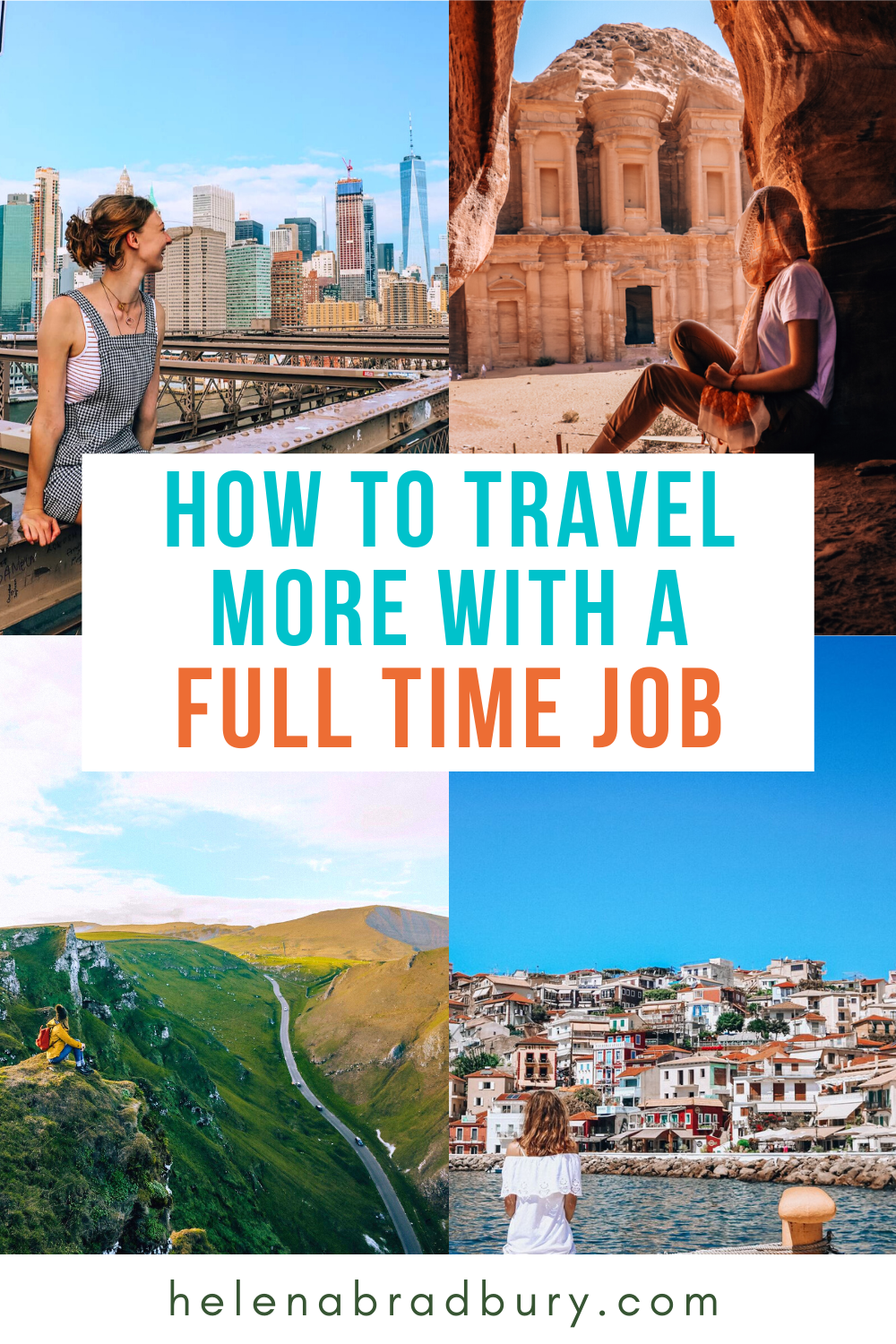The reason I started my Instagram and blog is because I believe that you don’t need to be rich or have a huge following on social media to see the world.
Yes, being able to travel comes with a certain amount of privilege, but I want to make it clear that seeing the world and travelling is totally possible if you have a full time or 9-5 job.
So if you’re here wondering how to travel more with a full time job or even how to travel often with a full time job, I’m here to tell you how. Because that’s what I’ve always done.
I’ve worked full time since 2015 and in that time I’ve visited over 30 countries. Here’s how.
How to travel with a full-time job
5 days off work to spend 9 days in New York
1. Plan your holiday year in advance to maximise leave
This is absolutely key.
Knowing how to travel the world with a full time job takes a lot of planning. But that’s so you can maximise your paid time off to travel - see how to maximise your leave for 2022 here.
Here are some key things you need to know to plan:
Check when your company’s holiday year starts - not all start on January 1st.
What is your holiday allowance and does it include or exclude public holidays?
Is you holiday pro rata or pre-allocated
Do you have any carried over holiday to use?
Can you accrue TOIL (Time off in lieu) by working extra days?
Once you have this information, work out how many paid days off you are entitled to, how many public or bank holidays you will get and when your pro rata days are accrued.
Then use a calendar like this one to mark in one colour when your pro rata days become available. Then in another colour, block out the days, weekends or weeks you want to take leave.
By doing this, you can maximise your travel distance or possibilities on a weekend when there’s a public holiday. Or you can check and see that flights to a certain destination are a lot cheaper on that one week in May, so you can save the pro rata days you need for that.
I’ll cover knowing when to plan your trips in the next tips below.
2. Maximise your weekends and accept that you’ll be exhausted from it!
I would frequently take the bus to the airport straight from work on a Friday and get the last flight out to whichever European city I was visiting. I would then get the last flight back on Sunday night, the bus back home often in the early hours of Monday morning, before going back into work. A couple of times I even got a 5am flight back on a Monday morning and was at my desk by 9am (thank you time difference for giving me an extra hour leeway!)
Of course you don’t even need to get on a plane. Take a weekend road trip to the next State over. Take a bus to a new city. Drive to the coast or to the mountains for the weekend.
I often get Americans saying to me, but it’s easy for you because you live so close to Europe! The key is making the most of what you have. Visiting Europe is that for me. But I’ve always been jealous of how diverse the landscape is in America. I have to go to Europe for mountains and canyons and pristine beaches, America has them all in one country!
I’m a big advocate that you don’t need to get on a plane to travel. And air travel is expensive. You’ll be amazed at how much beauty and diverse landscapes and places there are to visit in your own country when you approach it through the eyes of a traveller or tourist.
3. Extend your weekends with holiday days
Weekend in Latvia
Sometimes there are places or destinations that a weekend trip just will not do justice.
Perhaps you’re in the States and want to go to Mexico for 5 days. Or you’re in Europe and want to hop onto the north African continent and explore Marrakech and Morocco for 5 days.
Take your paid time off on the Friday, Monday and Tuesday, or Thursday, Friday and Monday.
By taking holiday days either side of your weekend, you’re getting two days of holiday ‘for free’ because you’re not using your paid time off.
Again, it can be a tiring way to travel if you get back in the evening and go to work the next morning. But it is by far the most effective way I’ve found to optimise my time off with limited annual leave available to me.
4. Ask your place of work for some flexibility in working hours
Left work early to go to the Algarve for the weekend
Figuring out how to travel more with a full time job doesn’t need to be hard work. Sometimes it’s as easy as asking your place of work if they have any flexible working policies.
When I was trying to maximise my weekend trips, I would often ask my manager if I could leave at 3pm or 4pm in order to make it to the airport on time, in exchange for this I would start my day earlier (7am at the office) or do the hours earlier in the week.
So many more companies are opening up to the idea of more flexible hours, especially if you don’t ask that often! If you’re a good worker who always gets things done on time, you might be surprised how willing to be lenient your boss is if you ask!
5. Travel at off-peak times of the day and in the off-peak seasons
This will really depend on when you want to travel, but if you have the flexibility, look at the off peak times or shoulder seasons to travel.
For Europe, I would always plan weekend city breaks in February and October/November because they’re the shoulder seasons when it’s less popular to visit, either because the weather isn’t as great or the Christmas markets haven’t started yet! Consider the peak time for travel to your destination before you book.
Even if you are travelling during a peak season, look for the off-peak and less popular flight times instead.
For example, if I look at the Friday afternoon flight to Riga in Latvia. The 6pm flight was almost £100 more than the flight at 11pm. Obviously the 11pm flight is less popular because it means you’re arriving at your destination in the early hours of the morning and people don’t want that. But it’s a huge money saver, especially if you’re flying with one of those budget airlines!
6. Use budget airlines and look for last minute deals
Love them or hate them, budget airlines are your friend if you’re trying to figure out how to travel when you have a full time job.
Not only are they great if you’re on a budget, but their cheapest flights are often because they operate at weird, off-peak times of the day (see my point above).
I could never get a midnight flight to Romania with British Airways but I could always get one with Ryanair or Wizzair!
Sign up to their newsletters and look out for their seasonal sales, you’ll often find great weekend deals in those because they’re often trying to sell off the less popular flight times that I mentioned above.
The same goes for looking out for sales deals on American airline carriers and Australian carriers. Having spent a long portion of time in both countries, they often have sales on flights, especially domestic flights!
7. Using public holidays are a great way to maximise your leave but be prepared to pay more
Travelling on the holidays is always more expensive, but there is a way to do it to still take advantage of your time off and keep costs down.
While most people will travel out at the start of the bank holiday weekend and return at the end of it. I try to travel on the reverse. For example, on the Easter bank holiday weekend (Friday - Monday, 4 day weekend) I would fly out to Europe on the Sunday or Monday when most UK travellers are returning from their trips. You’re flying the less popular route and direction at a given time which often means cheaper fares.
Yes you’ve not gone away for the whole public holiday weekend, but use the first couple of days to spend with friends and family, then take some of your annual leave and extend your trip out the other end, perhaps to Wednesday or Thursday.
This way you’ve still taken advantage of the public holiday and you’ve managed to see friends and travel in that time!
8. Explore locally and plan staycations
a weekend trip to do some hiking near my home
I’ve said it before and I’ll say it again. You do not need to get on a plane to travel.
I actually hate flying. I much prefer a road trip and they’re my favourite way to explore.
Pack up your car on the weekend and drive to that coastal town you’ve always wanted to visit or drive up to the mountains for a weekend of camping and hiking.
This is a great way to travel more while you work, keep costs down and not use your paid leave.
I was guilty of never exploring the UK because I thought there was nothing to see. I was so wrong. There is so much to see and my list continues to grow, even in a country as small as the UK!
When you plan a trip within your own country, look at it through the eyes of a traveller or tourist rather than a local. See the differences and the beauty and you might find, like me, that you become enamoured with your home country.
9. Check your company policy on overtime or TOIL
Many companies offer Time Off in Lieu if you work on a weekend or bank holiday when they aren’t your normal contracted hours.
Check if this is your company’s policy because if so, it’s a great way to accrue more leave.
I would aim to accrue TOIL in January or February working on the weekends so I could use the additional holiday days in the summer months when I wanted to have an extra day or two on my summer trips!
Even just one or two extra days can make such a difference to planning your holiday leave and travelling more with a full time job.
10. Check your company policy on remote working or sabbaticals
I’ve already mentioned speaking to your company about flexible working to occasionally change the hours you work to accommodate your travel.
But if you’re interested in a more long term change to travel with full time jobs, check if your company allows remote working or a certain number of remote working days per year.
This is one of the easiest ways to travel more without quitting your job.
I even have friends who have asked for flexible working and their company has offered the opportunity to work remotely for 30 days in any year. So they were able to take time off to travel somewhere new and then work from there. This is an amazing way to see more of a place but still have job security if you’re wondering how to travel while working remotely.
Another option is sabbaticals. Many companies will offer sabbaticals as a reward for employees who have been in the company’s service for a while.
From 6 week sabbaticals to a year sabbatical, I’ve seen them all offered and jobs that allow you to travel like that are another amazing opportunity if you want to travel but maintain your job security.
11. Take time off between jobs
This one doesn’t apply as much because obviously you don’t have a job at the time of travelling.
But if you already have a new job to go to, try pushing the start date a bit later by a month, or even a couple of weeks.
I’ve done this twice and backpacked around Asia for a month on one occasion and Interrailed around Europe for a month on another occasion.
This is another great option to squeeze as much travel as possible in your life but you still have the security of a job to go back to!
I hope you’ve found some useful advice or tips in this article on not only how to travel with a full time job but also how to travel more with a full time job by optimising and maximising the policies and leave options that might be available to you.
Let me know if you have any other tips!
Pin this post to save these tips for later!







